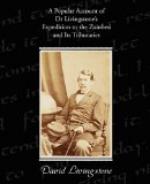On the ascent at the end of the valley just opposite Mount Mvai, we looked back for a moment to impress the beauties of the grand vale on our memory. The heat of the sun was now excessive, and Masiko, thinking that it was overpowering, proposed to send forward to the ship and get a hammock, in which to carry any one who might knock up. He was truly kind and considerate. Dr. Livingstone having fallen asleep after a fatiguing march, a hole in the roof of the hut he was in allowed the sun to beat on his head, and caused a splitting headache and deafness: while he was nearly insensible, he felt Masiko repeatedly lift him back to the bed off which he had rolled, and cover him up.
On the 24th we were again in Banda, at the village of Chasundu, and could now see clearly the hot valley in which the Shire flows, and the mountains of the Manganja beyond to our south-east. Instead of following the road by which we had come, we resolved to go south along the Lesungwe, which rises at Zunje, a peak on the same ridge as Mvai, and a part of Kirk’s Range, which bounds the country of the Maravi on our west. This is about the limit of the beat of the Portuguese native traders, and it is but recently that, following our footsteps, they have come so far. It is not likely that their enterprise will lead them further north, for Chasundu informed us that the Babisa under-sell the agents from Tette. He had tried to deal with the latter when they first came; but they offered only ten fathoms of calico for a tusk, for which the Babisa gave him twenty fathoms and a little powder. Ivory was brought to us for sale again and again, and, as far as we could judge, the price expected would be about one yard of calico per pound, or possibly more, for there is no scale of prices known. The rule seems to be that buyer and seller shall spend a good deal of time in trying to cheat each other before coming to any conclusion over a bargain.
We found the Lesungwe a fine stream near its source, and about forty feet wide and knee-deep, when joined by the Lekudzi, which comes down from the Maravi country.
Guinea-fowl abounded, but no grain could be purchased, for the people had cultivated only the holmes along the banks with maize and pumpkins. Time enough had not elapsed since the slave-trader’s invasion, and destruction of their stores, for them to raise crops of grain on the adjacent lands. To deal with them for a few heads of maize was the hungry bargaining with the famished, so we hastened on southwards as fast as the excessive heat would allow us. It was impossible to march in the middle of the day, the heat was so intolerable; and we could not go on at night, because, if we had chanced to meet any of the inhabitants, we should have been taken for marauders.




